IceCube South Pole
Non-EO
Quick facts
Overview
| Mission type | Non-EO |
| Launch date | Dec 2010 |
IceCube — South Pole Neutrino Observatory
IceCube Collaboration Mission Status References
The IceCube Neutrino Observatory is the first detector of its kind, designed to observe the cosmos from deep within the South Pole ice. An international group of scientists responsible for the scientific research makes up the IceCube Collaboration. 1)
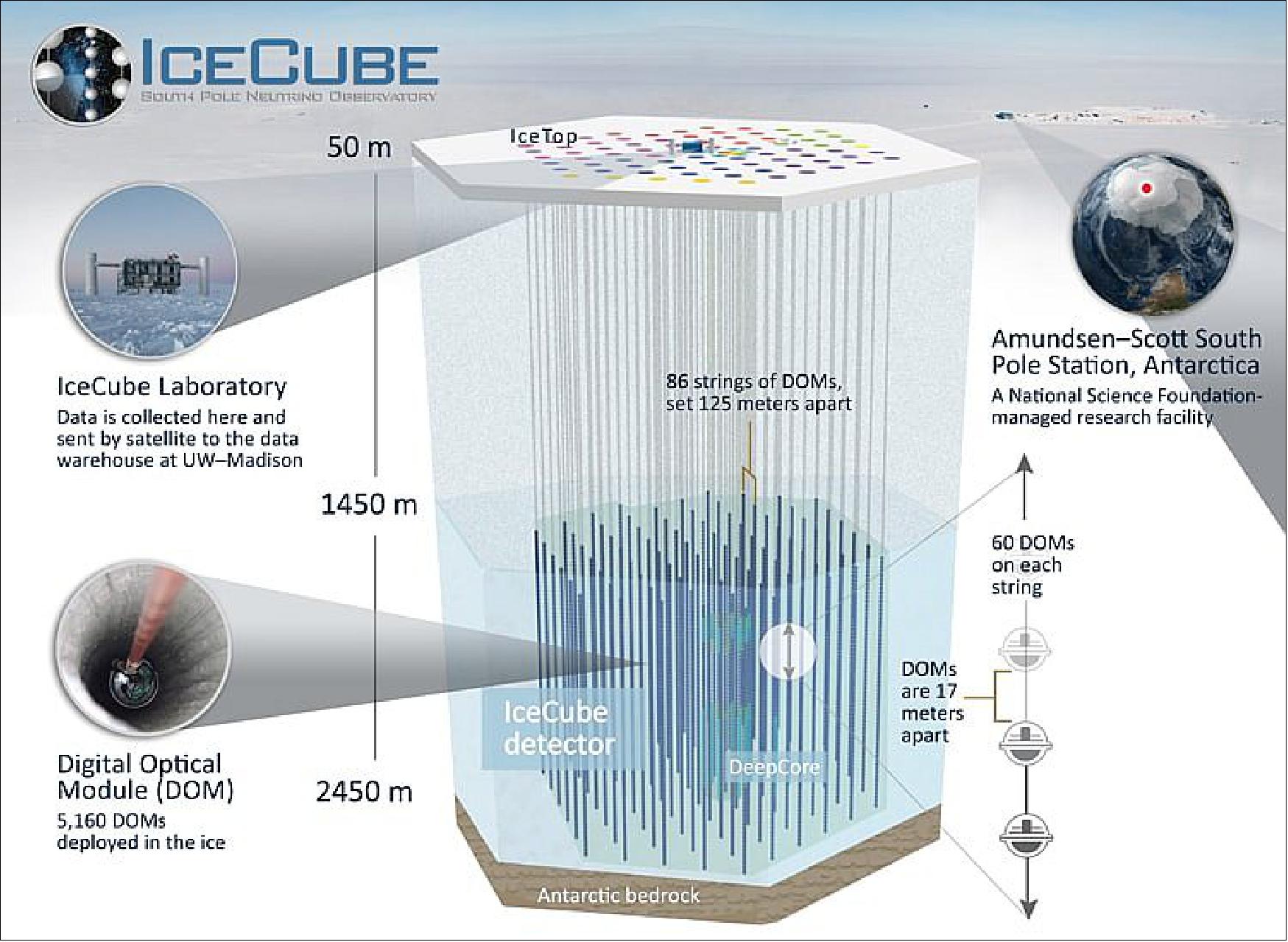
IceCube is the first gigaton neutrino detector ever built and was primarily designed to observe neutrinos from the most violent astrophysical sources in our universe. Neutrinos, almost massless particles with no electric charge, can travel from their sources to Earth with essentially no attenuation and no deflection by magnetic fields.
The in-ice component of IceCube consists of 5,160 digital optical modules (DOMs), each with a ten-inch photomultiplier tube and associated electronics. The DOMs are attached to vertical “strings,” frozen into 86 boreholes, and arrayed over a cubic kilometer from 1,450 meters to 2,450 meters depth. The strings are deployed on a hexagonal grid with 125 meters spacing and hold 60 DOMs each. The vertical separation of the DOMs is 17 meters.
Eight of these strings at the center of the array were deployed more compactly, with a horizontal separation of about 70 meters and a vertical DOM spacing of 7 meters. This denser configuration forms the DeepCore subdetector, which lowers the neutrino energy threshold to about 10 GeV, creating the opportunity to study neutrino oscillations.
IceTop consists of 81 stations located on top of the same number of IceCube strings. Each station has two tanks, each equipped with two downward facing DOMs. IceTop, built as a veto and calibration detector for IceCube, also detects air showers from primary cosmic rays in the 300 TeV to 1 EeV (1012 - 1018 eV)energy range. The surface array measures the cosmic-ray arrival directions in the Southern Hemisphere as well as the flux and composition of cosmic rays.
Detector Construction
Developments in neutrino astronomy have been driven by the search for the sources of cosmic rays, leading at an early stage to the concept of a cubic-kilometer neutrino detector. Cosmic rays, which consist mainly of protons, are the highest energy particles ever observed, with energies over a million times those reached by today’s particle accelerators on Earth.
AMANDA (Antarctic Muon and Neutrino Detector Array), was built as a proof of concept in the mid 1990s and demonstrated that the extremely clear Antarctic ice was suitable for detecting energetic neutrinos. IceCube, the only cubic-kilometer neutrino detector constructed to date, was completed in December 2010, only six years after the deployment of the first string at the South Pole.
Neutrinos are not observed directly, but when they happen to interact with the ice they produce electrically charged secondary particles that in turn emit Cherenkov light, as a result of traveling through the ice faster than light travels in ice.
The IceCube sensors collect this light, which is subsequently digitized and time stamped. This information is sent to computers in the IceCube Lab on the surface, which converts the messages from individual DOMs into light patterns that reveal the direction and energy of muons and neutrinos.
The IceCube Neutrino Observatory was built under a National Science Foundation (NSF) Major Research Equipment and Facilities Construction grant, with assistance from partner funding agencies around the world. The NSF Office of Polar Programs supports the project with a Maintenance and Operations (M&O) grant. The University of Wisconsin–Madison is the lead institution, coordinating data-taking and M&O activities. The international IceCube Collaboration, with more than 40 institutions worldwide, is responsible for the scientific research program.
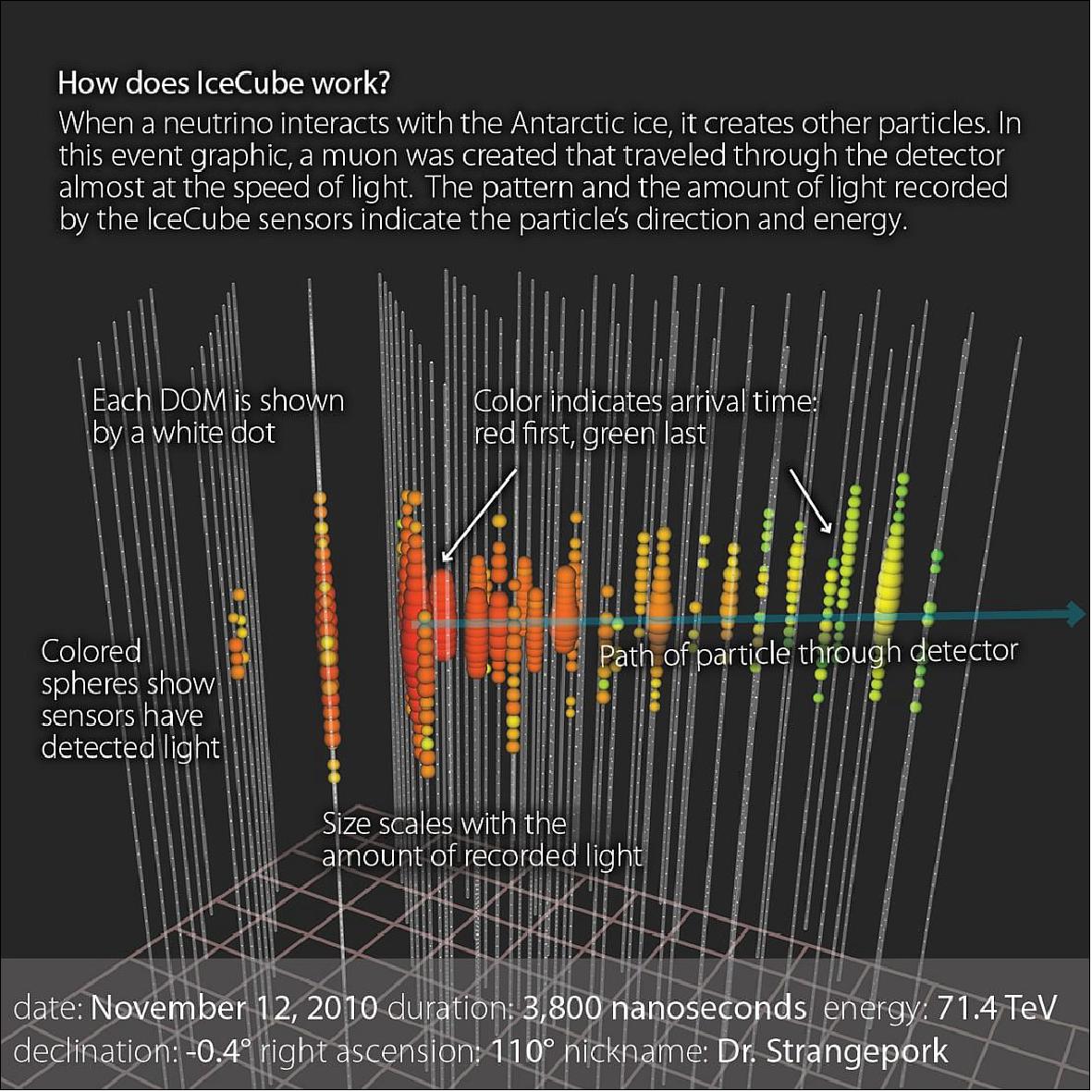
Construction
On December 18, 2010, just after 6 pm New Zealand time, the last of IceCube’s 86 strings was lowered into the Antarctic ice. Seven austral summers of construction had come to an end, and IceCube was completed a decade after the collaboration submitted the proposal.
Dedicated teams melted 60-centimeter diameter holes to a depth of 2,450 meters, deployed sensors, and commissioned strings from November to February each year from 2004 until 2011. Deployment specialists spent 11 hours on average to expertly connect sensors to a cable and lower them into the water-filled holes, which eventually refroze. In seven seasons, 86 holes in all were drilled and instrumented.
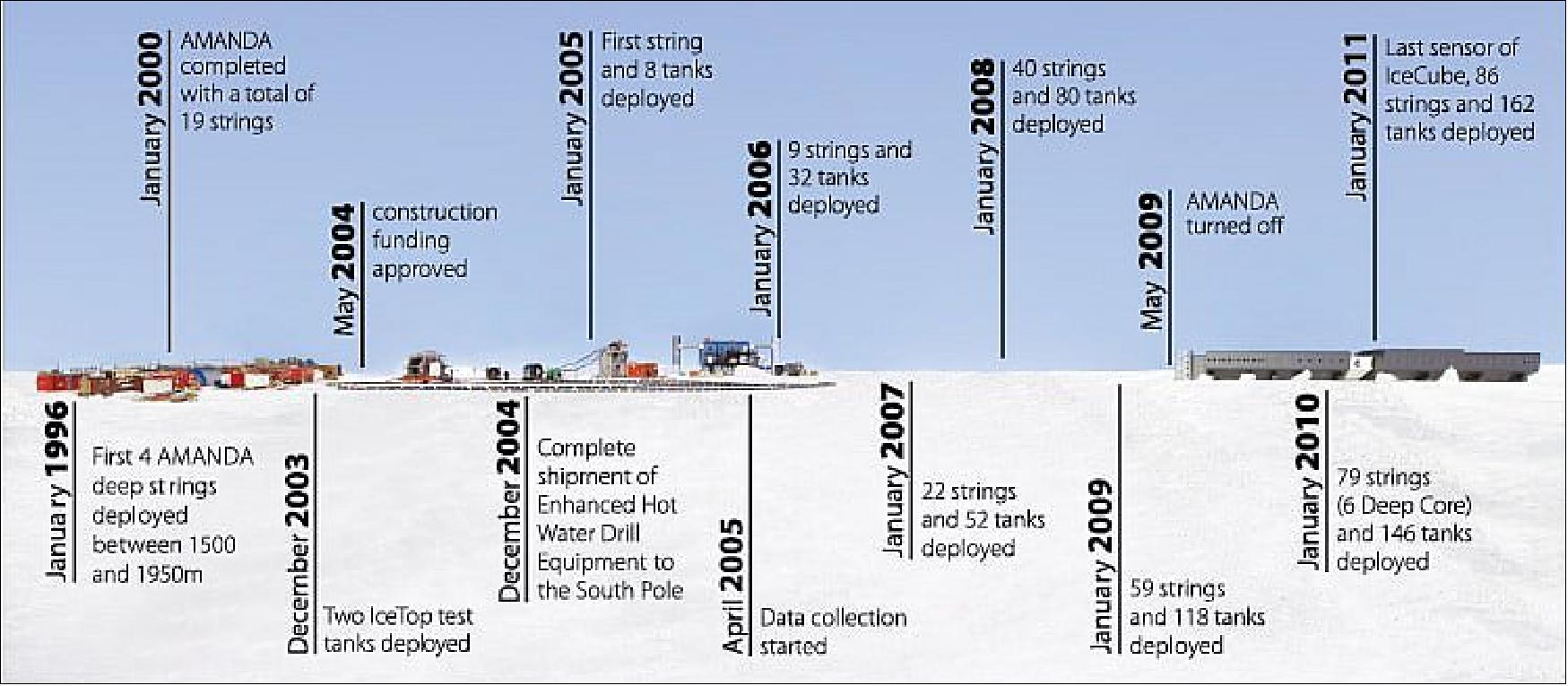
The drill was designed by the IceCube project and built at the UW Physical Sciences Lab. The high-pressure hose and nozzle delivered hot water that melted through the ice at record speeds, about 2 meters per minute, down to depths of 2,450 meters. A separate drill was designed and deployed to advance through the firn layer, the top 50 meters of compacted snow where hot water drilling is not efficient. Together the two drills were able to consistently produce almost perfect vertical holes ready for deployment of instrumentation at a rate of one hole every two days.
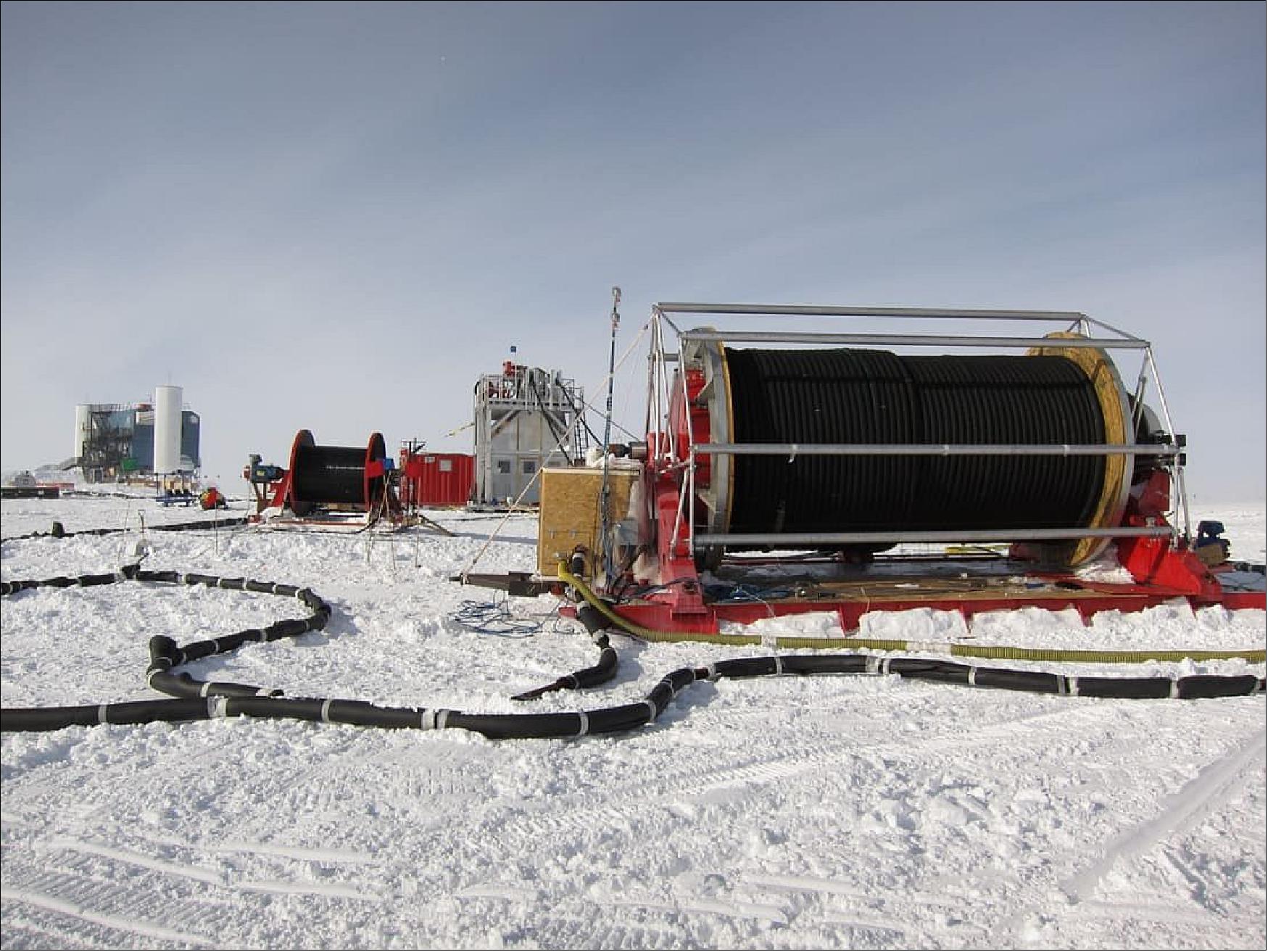
Since water starts to freeze immediately, IceCube sensors were quickly deployed following drilling. Once the refreezing process ended, which took a couple of weeks to stabilize, the failure rate of the instrumentation has been extremely low—fewer than 100 of the approximately 5,500 sensors are currently nonoperational.
IceCube sensors, designed with main contributions from Lawrence Berkeley National Laboratory, DESY-Zeuthen, and UW–Madison, were produced and tested at the universities in Stockholm and Uppsala in Sweden, DESY-Zeuthen in Germany, and the Physical Sciences Lab in Stoughton, Wisconsin, USA. Each string of sensors had a general theme, with a name given to each of the deployed sensors as a more effective means of identification rather than a numbering system.
Building IceCube was an extraordinary engineering achievement. It was completed on time, on budget, and significantly exceeding performance specifications. This is a tribute to the perseverance and dedication of the physicists, engineers, and technicians that overcame the many challenges of creating and operating a detector in such an inhospitable environment.
The total cost of construction was $279 million. The National Science Foundation provided around $242 million with the remaining funds coming from funding agencies in the US and abroad.
IceCube Collaboration
On the surface, building the IceCube Neutrino Observatory seems straightforward. A bunch of people traveled to the South Pole, drilled holes in the ice, and sent sensors down the holes. The reality is far from simple. 2)
The design and development of the detector was only possible thanks to the contributions of many individuals and institutions. Collectively, those individuals and institutions are known as the IceCube Collaboration.
Currently, the collaboration includes more than 300 people from 53 institutions in 12 countries. It began in 1999 with the submission of the first IceCube proposal, and many of the original members are still active on the project.

Over the years, the IceCube Collaboration has worked together on every aspect of the detector. Senior scientists, graduate students, technicians, software specialists, drillers, and engineers came together from around the world to build what is now the world’s largest neutrino detector.
One remarkable aspect of the construction phase was the wide distribution of the hardware development across the collaboration, from the main boards at Lawrence Berkeley National Lab to the construction of IceTop tanks and freeze control units at the University of Delaware. Production and testing of digital optical modules were done at three assembly facilities, at the University of Wisconsin–Madison, in Sweden and at DESY in Germany.
Although construction is complete, the project is far from over—there is science to be done. The collaboration continues to analyze data, discuss results, and plan future developments. While the logistics (semiannual meetings and weekly phone calls!) involved in maintaining efficient communication within the collaboration may seem cumbersome, the input of a wide variety of people fuels innovation and creativity.
Former spokesperson Prof. Tom Gaisser highlighted the benefits of a collaboration, saying, “The advantage of a collaboration is that working together makes it possible to accomplish what would be difficult or impossible for a few individuals or a single institution. In a successful collaboration the whole is more than the sum of its parts, and IceCube has already proved to be an outstandingly successful collaboration.”
While the official IceCube Collaboration is limited to institutions and organizations that participate in the science, the IceCube project is supported by an even wider group. Construction and operation of IceCube would not be possible without support from funding partners like the National Science Foundation (NSF), led by the Office of Polar Programs and the Physics Program, along with funding agencies in Sweden, Belgium, Germany, and other countries.
IceCube Upgrade
The IceCube Upgrade project has been underway since 2018, with funding provided through a grant from the National Science Foundation and with significant contributions and support from the following:
• Federal Ministry of Education and Research, Germany
• Helmholtz Association of German Research Centers, Germany
• Japan Society for the Promotion of Science (JSPS), Japan
• Ministry of Education, Culture, Sports, Science and Technology (MEXT), Japan
• National Research Foundation of Korea, Korea
• Michigan State University, USU
Maintenance And Operations
The continued maintenance and operations of IceCube is also supported through a combination of funding sources. The University of Wisconsin–Madison is the lead institution responsible for management of IceCube, with support from grants by the National Science Foundation. These funds are supplemented by contributions from other funding agencies outside the US as well as through in-kind contributions and service work performed by members of collaborating institutions. Other agencies providing significant sources of funding in support of IceCube maintenance and operations include:
• Funds for Scientific Research: (FNRS and FWO), Belgium
• Federal Office for Scientific, Technical and Cultural Affairs, Belgium
• Institute for the Promotion of Innovation by Science and Technology in Flanders, Belgium
• Federal Ministry of Research and Education, Germany
• German Research Foundation (DFG), Germany
• Inoue Foundation for Science, Japan
• Knut and Alice Wallenberg Foundation, Sweden
• Swedish Polar Research Secretariat, Sweden
• The Swedish Research Council, Sweden
• Department of Energy, Office of Science, USA
• University of Wisconsin Alumni Research Foundation, USA
Scientific Research
The scientific research efforts undertaken by the IceCube Collaboration are funded through separate grants provided by agencies within each collaborating country. The IceCube Collaboration authors gratefully acknowledge the support of these agencies (see acknowledgments here).

Construction
The construction of the IceCube Neutrino Observatory, completed in 2010, was made possible through generous support from the National Science Foundation (USA). Other significant sources of funding during construction include:
• Funds for Scientific Research: (FNRS and FWO), Belgium
• Federal Office for Scientific, Technical and Cultural Affairs
• German Research Foundation (DFG), Germany
• Deutsches Elektronen-Synchrotron (DESY), Germany
• Knut and Alice Wallenberg Foundation, Sweden
• Swedish Polar Research Secretariat, Sweden
• The Swedish Research Council, Sweden
• University of Wisconsin Alumni Research Foundation, USA
Mission Status
• March 10, 2021: On December 6, 2016, a high-energy particle called an electron antineutrino hurtled to Earth from outer space at close to the speed of light carrying 6.3 petaelectronvolts (PeV, or 1015 eV) of energy. Deep inside the ice sheet at the South Pole, it smashed into an electron and produced a particle that quickly decayed into a shower of secondary particles. The interaction was captured by a massive telescope buried in the Antarctic glacier, the IceCube Neutrino Observatory. 3)
- IceCube had seen a Glashow resonance event, a phenomenon predicted by Nobel laureate physicist Sheldon Glashow in 1960. With this detection, scientists provided another confirmation of the Standard Model of particle physics. It also further demonstrated the ability of IceCube, which detects nearly massless particles called neutrinos using thousands of sensors embedded in the Antarctic ice, to do fundamental physics. The result was published on March 10 in Nature. 4)
- Sheldon Glashow first proposed this resonance in 1960 when he was a postdoctoral researcher at what is today the Niels Bohr Institute in Copenhagen, Denmark. There, he wrote a paper in which he predicted that an antineutrino (a neutrino’s antimatter twin) could interact with an electron to produce an as-yet undiscovered particle—if the antineutrino had just the right energy—through a process known as resonance.
- When the proposed particle, the W– boson, was finally discovered in 1983, it turned out to be much heavier than what Glashow and his colleagues had expected back in 1960. The Glashow resonance would require a neutrino with an energy of 6.3 PeV, almost 1,000 times more energetic than what CERN’s Large Hadron Collider is capable of producing. In fact, no human-made particle accelerator on Earth, current or planned, could create a neutrino with that much energy.
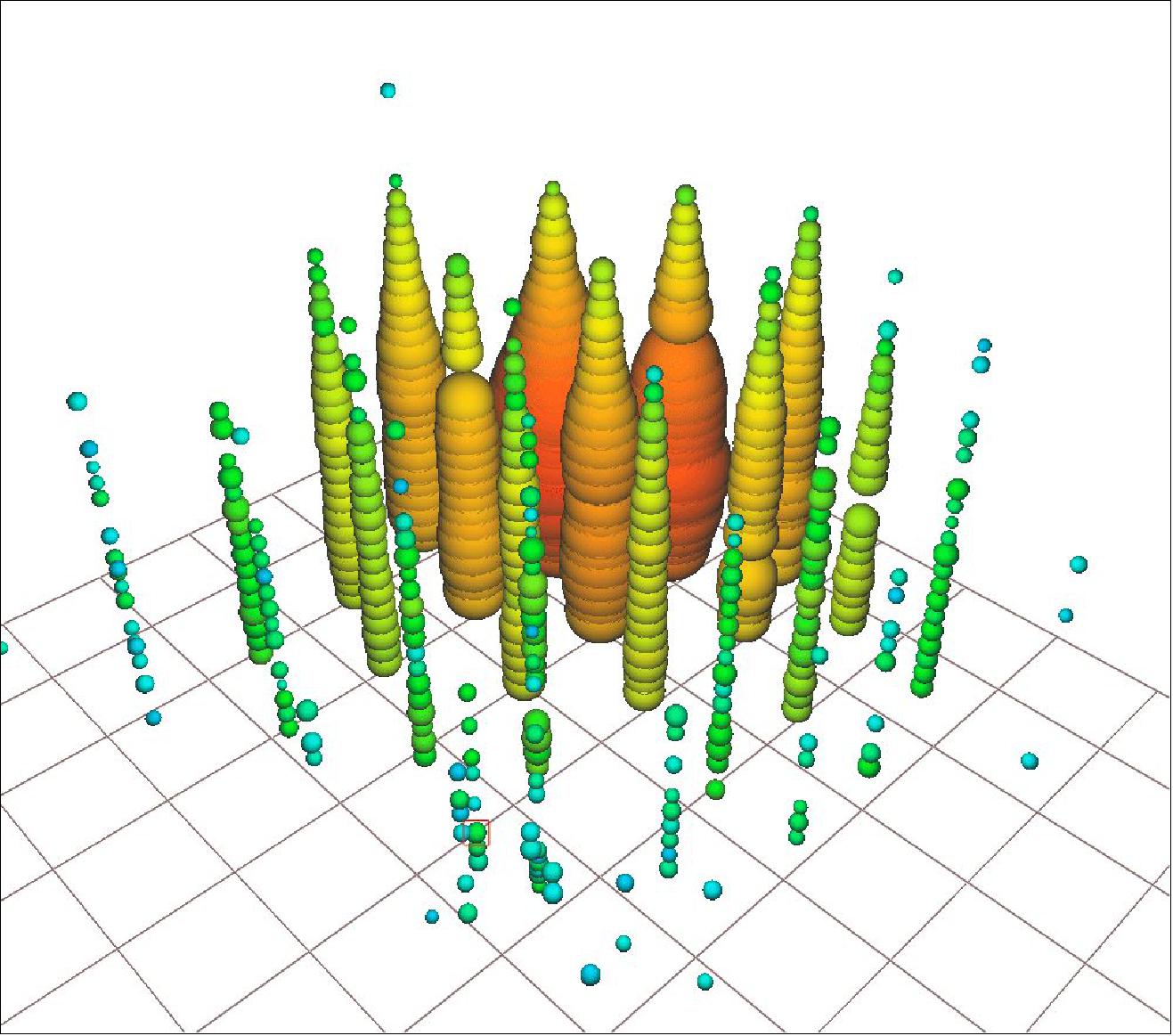
![Figure 9: A South Pole scene of the IceCube Laboratory against a backdrop of auroras displayed inside an artistic rendition of a photomultiplier tube. The resonance is depicted as a glowing blue rod, representing the first string in IceCube to observe early pulses from the event [image credit: IceCube Collaboration (ICL photo by Yuya Makino, IceCube/NSF)]](https://eoportal.org/ftp/satellite-missions/i/IceCubeSothPole-16032021/IceCubeSothPole_Auto9.jpeg)
- But what about a natural accelerator—in space? The enormous energies of supermassive black holes at the centers of galaxies and other extreme cosmic events can generate particles with energies impossible to create on Earth. Such a phenomenon was likely responsible for the 6.3 PeV antineutrino that reached IceCube in 2016.

- “When Glashow was a postdoc at Niels Bohr, he could never have imagined that his unconventional proposal for producing the W– boson would be realized by an antineutrino from a faraway galaxy crashing into Antarctic ice,” says Francis Halzen, professor of physics at the University of Wisconsin–Madison, the headquarters of IceCube maintenance and operations, and principal investigator of IceCube.
- Since IceCube started full operation in May 2011, the observatory has detected hundreds of high-energy astrophysical neutrinos and has produced a number of significant results in particle astrophysics, including the discovery of an astrophysical neutrino flux in 2013 and the first identification of a source of astrophysical neutrinos in 2018. But the Glashow resonance event is especially noteworthy because of its remarkably high energy; it is only the third event detected by IceCube with an energy greater than 5 PeV.
- “This result proves the feasibility of neutrino astronomy—and IceCube’s ability to do it—which will play an important role in future multimessenger astroparticle physics,” says Christian Haack, who was a graduate student at RWTH Aachen while working on this analysis. “We now can detect individual neutrino events that are unmistakably of extraterrestrial origin.”
- The result also opens up a new chapter of neutrino astronomy because it starts to disentangle neutrinos from antineutrinos. “Previous measurements have not been sensitive to the difference between neutrinos and antineutrinos, so this result is the first direct measurement of an antineutrino component of the astrophysical neutrino flux,” says Lu Lu, one of the main analyzers of this paper, who was a postdoc at Chiba University in Japan during the analysis.
- “There are a number of properties of the astrophysical neutrinos’ sources that we cannot measure, like the physical size of the accelerator and the magnetic field strength in the acceleration region,” says Tianlu Yuan, an assistant scientist at the Wisconsin IceCube Particle Astrophysics Center and another main analyzer. “If we can determine the neutrino-to-antineutrino ratio, we can directly investigate these properties.”
- To confirm the detection and make a decisive measurement of the neutrino-to-antineutrino ratio, the IceCube Collaboration wants to see more Glashow resonances. A proposed expansion of the IceCube detector, IceCube-Gen2, would enable the scientists to make such measurements in a statistically significant way. The collaboration recently announced an upgrade of the detector that will be implemented over the next few years, the first step toward IceCube-Gen2.
- Glashow, now an emeritus professor of physics at Boston University, echoes the need for more detections of Glashow resonance events. “To be absolutely sure, we should see another such event at the very same energy as the one that was seen,” he says. “So far there’s one, and someday there will be more.”
- Last but not least, the result demonstrates the value of international collaboration. IceCube is operated by over 400 scientists, engineers, and staff from 53 institutions in 12 countries, together known as the IceCube Collaboration. The main analyzers on this paper worked together across Asia, North America, and Europe.
- “The detection of this event is another ‘first,’ demonstrating yet again IceCube’s capacity to deliver unique and outstanding results,” says Olga Botner, professor of physics at Uppsala University in Sweden and former spokesperson for the IceCube Collaboration.
- “IceCube is a wonderful project. In just a few years of operation, the detector discovered what it was funded to discover—the highest energy cosmic neutrinos, their potential source in blazars, and their ability to aid in multimessenger astrophysics,” says Vladimir Papitashvili, program officer in the Office of Polar Programs of the National Science Foundation, IceCube’s primary funder. James Whitmore, program officer in NSF Division of Physics, adds, “Now, IceCube amazes scientists with a rich fount of new treasures that even theorists weren’t expecting to be found so soon.”
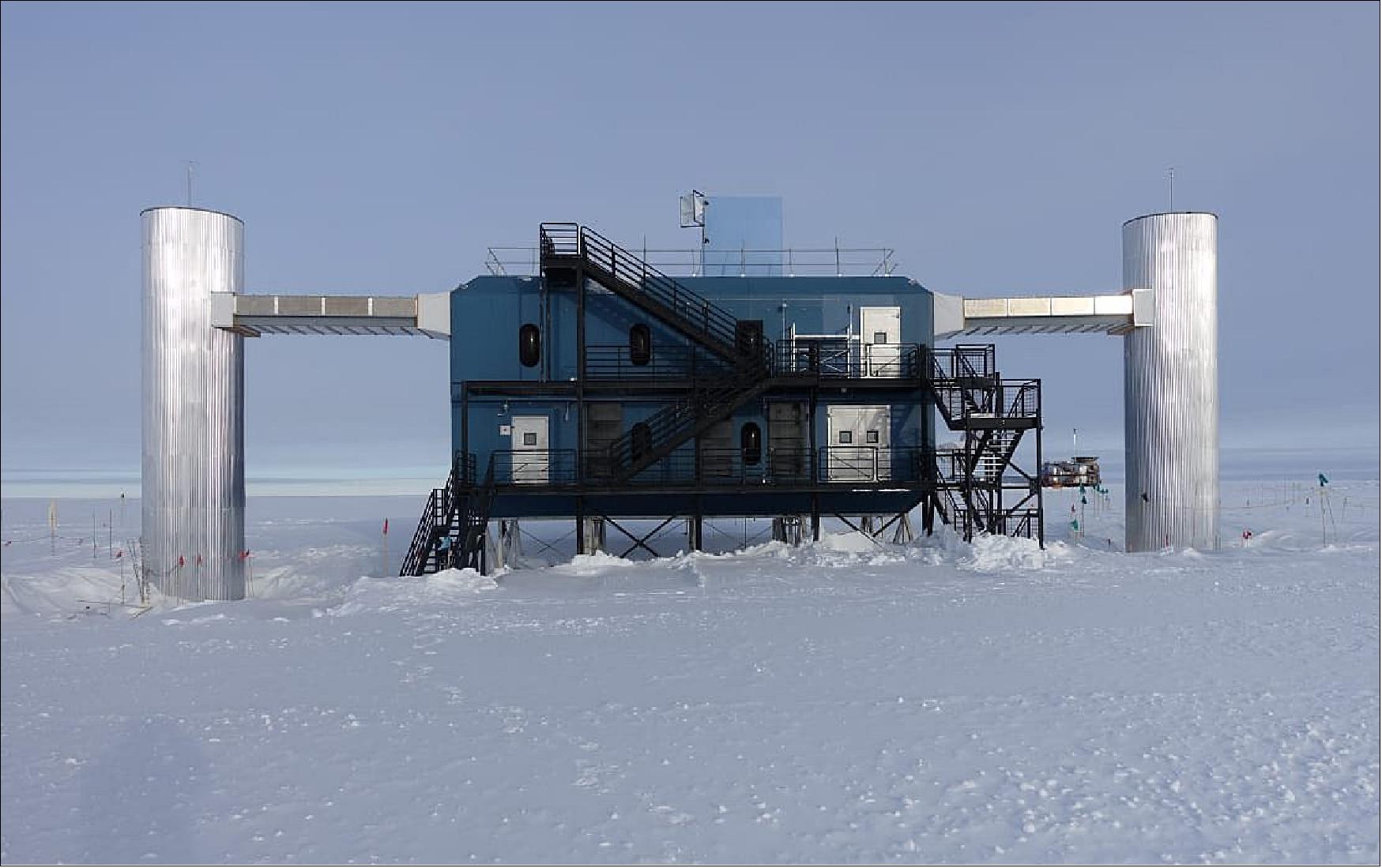
• December 3, 2020: The IceCube Neutrino Observatory is an unusual telescope. It uses its over-5,000 optical sensors embedded in the South Pole ice to look for signals from astrophysical neutrinos, nearly massless subatomic particles from outer space. One of IceCube’s main goals is to pinpoint sources of these neutrinos, of which there are many. 5)
- Since a 2013 IceCube paper showed the first solid evidence for astrophysical neutrinos from cosmic accelerators, we have learned some things about the sources of these mysterious particles. In 2017, IceCube detected a neutrino coming from a blazar called TXS 0506+056, the first compelling evidence of an astrophysical neutrino source. And a recent analysis of 10 years of IceCube data singled out another potential source: the Seyfert II galaxy NGC 1068, a type of active galactic nuclei.
- However, sources of most astrophysical neutrinos remain unknown, and the IceCube Collaboration continues to search for them using a variety of analysis methods. In a paper submitted yesterday to The Astrophysical Journal, the collaboration describes a time-dependent all-sky scan using five years of IceCube data as well as a specific analysis of blazar 3C 279. The method involves looking for neutrinos clustered in both time and space—in other words, neutrinos that came from the same spot in the sky and arrived within a certain period. This analysis, which is an update of a previous time-dependent all-sky scan from 2015, did not reveal any new neutrino point sources.
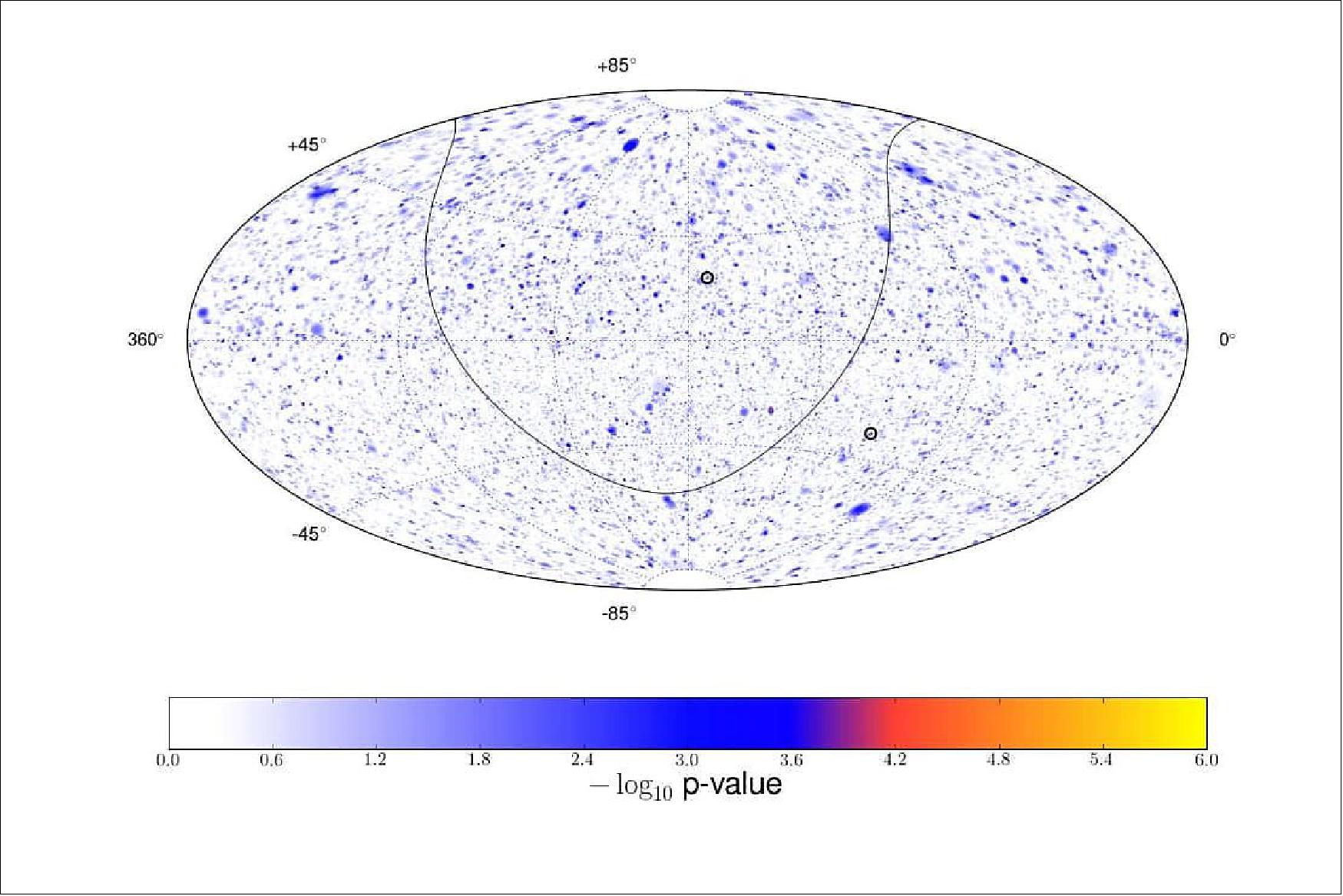
- We don’t know a lot about neutrino sources, which makes it a challenge to look for them. IceCube researchers perform many different searches under different hypotheses, including time-integrated searches (used to find the potential source NGC 1068) and time-dependent searches. Unlike time-integrated searches, time-dependent searches consider the neutrinos’ times of arrival at IceCube, focusing on neutrinos clustered in both space and time. Time-dependent searches have a better discovery potential than time-integrated searches for a potential continuous emission of neutrino signal that lasts less than 100 days. Plus, searching for neutrinos that cluster both spatially and temporally helps further separate potential neutrino signals from background, as researchers expect the background flux of neutrinos to be constant in time.
- IceCube researchers took the time-dependent approach for the all-sky scan of five years of IceCube data. “We developed this likelihood method over the years starting with my time at the University of Wisconsin–Madison,” says Teresa Montaruli, now a professor in the particle physics department at the University of Geneva in Switzerland.
- “We don’t assume anything about the source, but only search for clustering of astrophysical neutrinos in space and time over the whole sky,” says Stéphanie Bron, a PhD student at the University of Geneva and a lead on this analysis.
- Montaruli, Bron, and their colleagues examined the sky in 0.1-by-0.1 degree squares and calculated whether neutrino data in each square was compatible with what they expected for background. The point found to be least compatible with background in each hemisphere was deemed the “hottest spot.”
- Over the five years that the researchers scanned, no new astrophysical neutrino point source was found. The most significant hotspot was compatible with background fluctuation and was not associated with a known gamma-ray source. However, the second-most significant hotspot was compatible with the location of TXS 0506+056, the blazar from the 2017 detection, though it was not a significant result in this analysis. Bron says this discrepancy is because they did not focus the scan on this part of the sky. “Because we are not looking only in the direction of TXS, but scanning the whole sky, we are penalized by the huge trial factor, which greatly reduces the final significance of the result,” she says. “It is interesting to see in practice the kind of effect that those trial factors might have, and this really points to the importance of using multimessenger signals to drive the search for cosmic neutrinos.”
- The researchers also tried their method in a more focused search. With measurements from the Fermi-LAT gamma-ray telescope, they targeted blazar 3C 279, which underwent an exceptionally bright flare on June 16, 2015. Seeing gamma rays and neutrino emission from the same source would be a strong indication of a cosmic ray source, so this blazar was an ideal object to examine.
- For this part of the analysis, researchers only looked at the sky in the direction of the blazar and only analyzed eleven days of IceCube data centered on the day of the flare. Alas, the analysis revealed no significant results. However, the researchers were able to establish an upper limit to constrain a model of the number of neutrino events associated with this specific flare of 3C 279 that IceCube should detect under certain assumptions about the gamma-ray emission observed by Fermi-LAT.
- Still, Montaruli, Bron, and their colleagues believe that this type of time-dependent analysis should continue. “Even though the analyzed data sets didn’t lead to any significant results, a future data set might,” says Bron. “The nice thing about this kind of analysis is that it doesn’t depend on any assumption about the shape, duration, or source of the signal. So it is sensitive to a whole range of phenomena, including gamma-ray bursts and active galactic nuclei, but also phenomena that maybe we don’t even know exist. And this is the exciting part to me!” 6)
• November 12, 2020: Over the past decade, the burgeoning field of neutrino astronomy has made huge strides, from the first indication of very high energy neutrinos coming from outside our solar system announced in 2013 to the first observed extragalactic source of high-energy neutrinos in 2017. But there is still a lot to learn about these mysterious, lightweight subatomic particles and what they can teach us about the universe. 7)
- The IceCube Neutrino Observatory, an array of over 5,000 light detectors embedded in a cubic kilometer of ice at the South Pole, is the largest neutrino telescope on Earth. In the past, most IceCube searches for astrophysical neutrinos focused on high-energy neutrinos, specifically, neutrinos with energies between 1012 and 1015 electronvolts (TeV to PeV). Other neutrino detectors around the world, such as Super-Kamiokande in Japan, carry out searches for neutrinos with lower energies.
- In a paper submitted recently to the Journal of Cosmology and Astroparticle Physics, the IceCube Collaboration describes a search for sub-TeV neutrino emission from astrophysical “transient” sources, which are sources that emit neutrinos primarily within a relatively short window of time. This is the first transient result from IceCube to use all neutrino flavors in the 1-100 GeV energy region. In the absence of any observed sources in three years of archival IceCube data, the researchers established new limits on the number of transients in a volume of space per year, known as the volumetric rate of transients.

- Gamma-ray bursts (GRBs) are quick, extremely energetic explosions of gamma ray light that are frequently explored as possible transient sources of neutrinos. Some scenarios predict that GRBs emit neutrinos of low energies (~10-100 GeV) without the usual gamma ray counterpart. This could happen, for example, if relativistic GRB jets are “choked off” by a dense envelope of matter before they become visible via their bright gamma-ray display; even if gamma rays cannot make it out, neutrinos (especially low-energy neutrinos) can get through and reach Earth.
- So, using neutrino data collected with the IceCube-DeepCore subarray between April 2012 and May 2015, IceCube collaborators searched for any low-energy neutrinos that were coincident in time and direction in a way that indicated a neutrino emission from a transient astrophysical phenomenon. Their analysis consisted of two parts: First, the researchers selected time windows in which there were particularly large densities of neutrino events. Next, they looked within each time window for neutrino events that came from points in the sky that were spatially close.
- Among the three years of archival data, the researchers found no transient neutrino emission. Consequently, they were able to place an upper limit on the volumetric rate of astrophysical transient sources.
- When the researchers compared their current upper limit to theoretical estimates, they found that they would need a significantly larger detector or improvements in analysis techniques in order to detect a transient point source by chance. Fortunately, IceCube’s low-energy neutrino triggering, simulations, and angular location algorithms have improved over the years and continue to improve.
- “Although we didn’t find any sources, it was exciting to explore the intersection between astro- and particle physics by utilizing all three neutrino flavors in the search for astrophysical phenomena that to this day remain unobserved,” says Mia-Louise Nielsen, a graduate student at the Niels Bohr Institute and one of the main analyzers.
- Along with IceCube collaborators, the researchers are now adapting the method used here to a real-time analysis to complement the existing high-energy real-time alert systems. Currently, the alert system notifies observatories around the world whenever IceCube sees a high-energy neutrino candidate event that meets certain criteria; adapting this analysis would extend the alerts’ energy range down to 10 GeV, opening up a new, unexplored energy regime for real-time follow-up.
- “Multimessenger astronomy has entered a new era when it comes to using high-energy neutrinos to view the wider universe,” says Jason Koskinen, an associate professor at the Niels Bohr Institute. “With this analysis, we are taking some of the first steps in using lower energy neutrinos to probe an otherwise unexplored energy region.”
- The authors point out that, while this analysis was optimized for a specific class of GRBs, it is also sensitive to many other transient neutrino emitters that may exist in the sub-TeV region but have not yet been predicted by theorists. With the forthcoming IceCube Upgrade in the early 2020s and the possibility of making correlations with other astrophysical messengers, a new multimessenger discovery is perhaps just around the corner (Ref. 6).
• August 18, 2020: On December 18, 2010, IceCube’s final DOM (digital optical module) was lowered into a hole in the ice at the South Pole. After seven years of construction—and many more years of international collaboration around design and planning—the IceCube Neutrino Observatory was complete. The detector now had 5,160 DOMs on 86 cables (“strings”) frozen into a cubic kilometer of the Antarctic glacier ice, waiting for signals from tiny, ghostlike particles from outer space called neutrinos. 8)
- Since then, IceCube has done exactly what it was built to do: use astrophysical neutrinos to peer into the otherwise indiscernible universe, where light and other particles are obstructed. In the past decade, the IceCube Collaboration has published over 150 papers on astrophysics, neutrino physics, dark matter, glaciology, cosmic ray physics, instrumentation, and much more. Most notably, IceCube detected the first high-energy astrophysical neutrinos in 2013 and led the effort in the first-ever identification of a source of extragalactic neutrinos and high-energy cosmic rays in 2018—a discovery that proved the potential of neutrinos in multimessenger astronomy.
- But to make new physics discoveries and continue to probe the mysteries of the universe, bigger and more sensitive detectors are needed. Enter IceCube-Gen2.
- In a white paper recently submitted to the Journal of Physics G, the international IceCube-Gen2 Collaboration outlines the need for and design of a next-generation extension of IceCube. By adding new optical and radio instruments to the existing detector, IceCube-Gen2 will increase the annual rate of cosmic neutrino observations by an order of magnitude, and its sensitivity to point sources will increase to five times that of IceCube.
- “IceCube-Gen2 will build upon two discoveries by IceCube,” says Albrecht Karle, an IceCube-Gen2 coordinator based at the University of Wisconsin–Madison. “One is the presence of a large cosmic neutrino flux at high energies; the other is the exceptional clarity of the ice. By optimizing the design, we can scale the detector up by one order of magnitude with very similar instrumentation.”
- Projected to be completed in 2033 with construction costs around $350 million, IceCube-Gen2 is designed to address some of the biggest questions in multimessenger astronomy and neutrino physics.

- “Publishing a white paper is an important milestone for every future research project,” says Markus Ackermann, head of the IceCube group at DESY in Zeuthen, Germany. “With this document, we want to share our enthusiasm about the scientific potential of IceCube-Gen2 with the broader scientific community and outline a path toward the realization of this exciting project.”
- IceCube-Gen2’s design is a major endeavor that will entail years of construction. The first step is already underway with the NSF-sponsored IceCube Upgrade, which will add seven strings with new and enhanced optical modules to DeepCore, the center of the IceCube array. The next phase will be to add the rest of the 120 new strings, which will be spaced about 240 meters apart in a sunflower-like pattern around IceCube that is designed to encompass a large volume while avoiding “corridors” through which misleading signals may pass. The new optical modules, which should be able to collect nearly three times as many photons as current IceCube DOMs, will be spaced 16 meters apart on the string, between 1.3 and 2.6 kilometers below the surface, resulting in a total detector volume of nearly eight cubic kilometers.
- Near the surface, IceCube-Gen2 will have a new radio component made up of detector “stations” covering an area of approximately 500 square kilometers. Each station consists of three strings holding radio antennas that will be deployed close to the surface of the ice. This array will detect radio emission generated in the ice by particle showers, allowing scientists to reconstruct the energy of the shower and arrival direction of the neutrino.

- IceCube-Gen2 is designed to address some of the mysteries that persist in neutrino and multimessenger astronomy. Specifically, the extension will allow us to resolve the high-energy neutrino sky at energies higher than ever before (energies up to EeV, or 1018 eV), investigate cosmic particle acceleration through multimessenger observations, reveal the sources and propagation of the highest energy particles in the universe, and probe fundamental physics with high-energy neutrinos. These advancements will shape the next era of multimessenger astronomy and revolutionize our understanding of the high-energy universe.
- “Over the past 30 years we have seen the exciting evolution of neutrino observations, from first neutrino detections using early instruments deployed deep in glacial ice sheets to the long-sought discovery of high-energy astrophysical neutrinos with IceCube,” says Darren Grant of Michigan State University, spokesperson for the current IceCube Collaboration. “IceCube-Gen2 represents the timely opportunity to build on existing expertise and technological advances to move from the discovery era to precision neutrino astronomy.”
- The collaboration already knows that IceCube-Gen2 is logistically possible. The construction of IceCube demonstrated the ability to build and deploy instruments on time and on budget in an Antarctic glacier at the South Pole—one of the most inhospitable environments on the planet. While there will be logistics challenges in such a large project, the collaboration is prepared to meet them, always taking into account that South Pole is hosting a multitude of scientific projects with their own logistical needs.
- From a global perspective, IceCube-Gen2 will transform the multimessenger astrophysics landscape; once built, the extended detector will join a network of other large-scale observatories that survey the sky in gamma rays, gravitational waves, and cosmic rays.
- “Neutrinos are but a recent addition to the palette of tools that help us explore the cosmos,” says Olga Botner, head of the IceCube group at Uppsala University in Sweden. “While IceCube opened a new window onto the distant, violent universe, with IceCube-Gen2 we will look further, with more precision and over a larger energy range. IceCube-Gen2 will play an essential role in the era of multimessenger astronomy, paving the way for new, groundbreaking discoveries.” 9)
• July 17, 2020: On August 17, 2017, the LIGO Scientific Collaboration and the Virgo Collaboration made the first-ever detection of minute ripples of space-time known as gravitational waves from merging neutron stars. Following the signal, other telescopes and observatories around the world detected the same source in visible light, gamma rays, ultraviolet light, X-rays, and radio waves. 10)
- It was the first gravitational wave event observed with an electromagnetic counterpart, crowning a new era of multimessenger astronomy—the coordination of observations from different “messengers.” Multimessenger observations provide unique insight into astrophysical sources: Different messengers are emitted during different times and from different subprocesses, allowing us to observe different epochs of the interaction and understand the whole process more completely.
- Other than gravitational waves and electromagnetic radiation, subatomic particles called neutrinos also make excellent messengers. Chargeless and nearly massless, neutrinos are capable of traveling for billions of light-years undisturbed. It is the goal of the IceCube Neutrino Observatory at the South Pole to detect them.
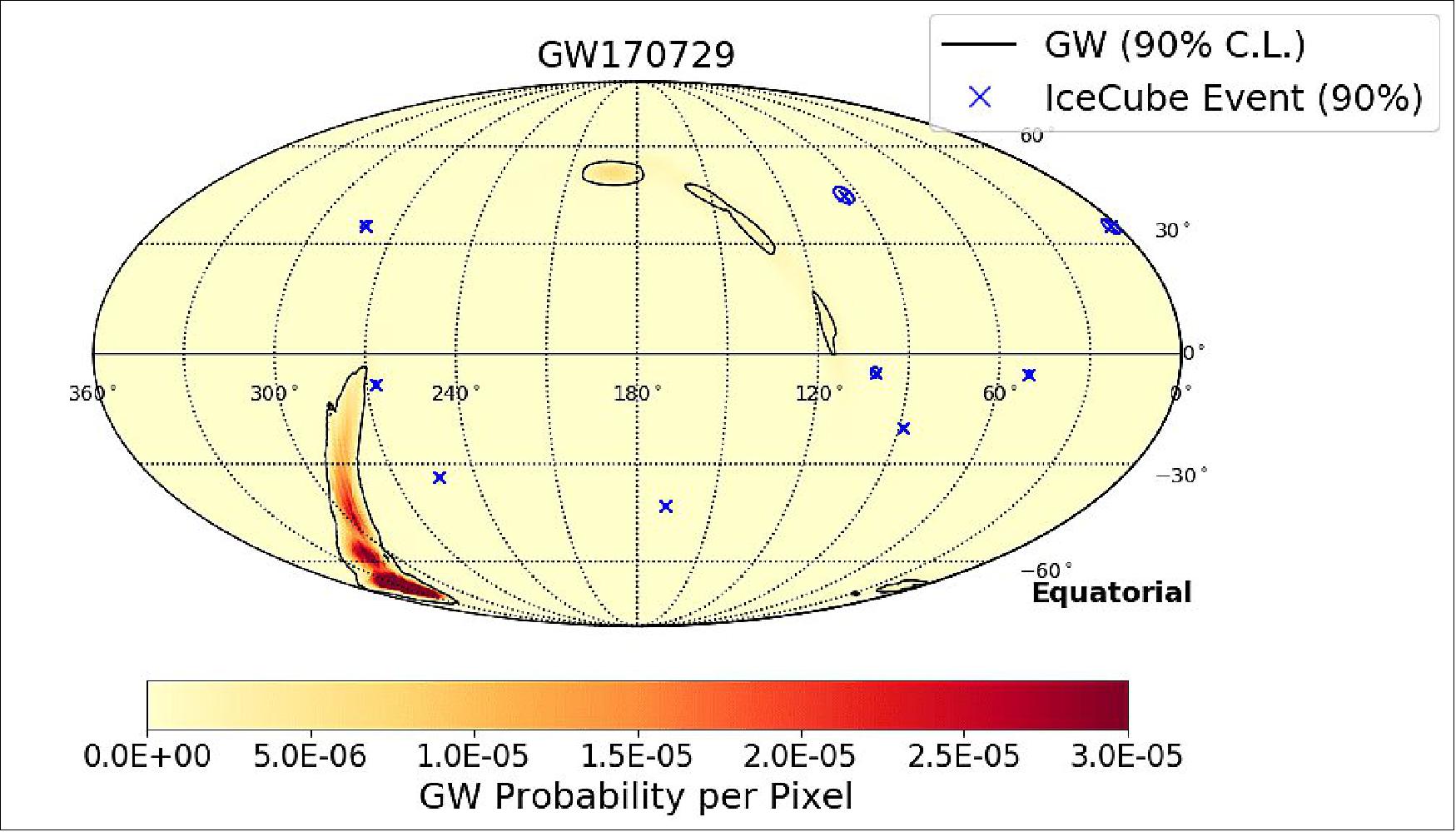
- While we have seen neutrinos and electromagnetic radiation with a common origin, researchers have yet to detect neutrinos and gravitational waves coming from the same place. So the IceCube Collaboration recently performed an analysis to look for neutrino emission that correlates with gravitational waves detected by the LIGO and Virgo Collaborations during their first two observing runs, O1 and O2. Their results are described in a paper published today in The Astrophysical Journal Letters. No coincidence was found, but the researchers are already at work on further analyses.
- To date, all signals detected by the LIGO and Virgo interferometers have come from compact binary mergers: orbiting pairs of massive and dense—”compact”—objects, such as neutron stars or black holes. For this IceCube analysis, collaborators from the University of Wisconsin–Madison, the University of Florida, and Columbia University in New York City searched for neutrinos from the 11 compact binary mergers from LIGO-Virgo’s first two observing runs: 10 binary black hole mergers and one binary neutron star merger.
- These mergers release an enormous amount of energy, some of which could go into accelerating cosmic rays to very high energies—possibly leading to neutrino production.
- “Observing neutrino emission from these mergers would allow us to probe the underlying physics better and understand the properties of the objects involved,” says Doğa Veske of Columbia University, one of the leads on this analysis. “We could also associate a source with high-energy neutrinos.”
- The researchers were searching for neutrino emission in IceCube data consistent with the time and location of a source responsible for the gravitational wave emission detected by LIGO-Virgo. It is estimated that there can be up to 500 seconds separating high-energy neutrino emission and gravitational wave emission from the same source, so researchers looked for neutrinos that arrived at IceCube in a 1000-second time window centered on the reported gravitational wave event time.
- One challenge was that LIGO-Virgo events are very poorly localized. “These gravitational wave observations are like hearing a sound rather than seeing something: It is hard to tell where, precisely, they come from in the sky,” says Veske. So the researchers had to rely on statistical methods to pick out a significant signal within the large localization region reported by LIGO-Virgo and and determine which—if any—neutrinos were coming from the same source as the gravitational wave.
- The searches did not identify significant neutrino emission from any of the 11 events reported by LIGO-Virgo. Nevertheless, the results allowed the researchers to set upper limits on the neutrino emission from each source as well as on the total energy emitted in high-energy neutrinos from each gravitational-wave event.
- Raamis Hussain, a graduate student at UW–Madison and another lead on the analysis, says that the null results aren’t too much of a surprise because most of the events are binary black hole mergers, which aren’t necessarily expected to produce neutrinos. In the case of the one binary neutron star merger, “We could have just gotten unlucky,” he says. “We’ll need more events from LIGO-Virgo to either confirm or rule out compact binary mergers as a neutrino source.”
- LIGO-Virgo just finished their third observing run, O3, in late March. Throughout O3, IceCube researchers tuned into LIGO-Virgo Open Public Alerts—high-significance gravitational-wave candidate events that were broadcast in near-real time—with two neutrino follow-up pipelines. This allowed the researchers to apply their searches to any new signals promptly.
- “This O1 and O2 analysis laid the groundwork for the ongoing real-time search for neutrinos from the gravitational wave sources reported nearly every week during O3,” says Justin Vandenbroucke, a UW–Madison physics professor and another lead on the paper. “A detection would revolutionize multimessenger astrophysics, and we can report coincident neutrino directions within about an hour of gravitational wave detection in order for telescopes to search a much smaller region of the sky for electromagnetic counterparts.”
- There are also other analyses in the works, one of which will perform the same search but on longer timescales. This will test some models that have predicted neutrino emission up to two weeks after the initial merger event.
- In another forthcoming analysis, the IceCube researchers plan on expanding the search to include a second type of neutrino event—”cascades”—in addition to the “tracks” that they currently examine, which will increase the number of neutrinos they can test.
- On the gravitational-wave side, a large set of event candidates that dig deeper into the noise floor of the LIGO and Virgo detectors was recently identified. The Columbia-Florida IceCube team will use this set to expand the horizon of the current search.
- “As one of the founders and an early pioneer of this field, I have been dreaming for a decade and a half about gravitational-wave–high-energy neutrino joint discovery,” says Zsuzsa Márka, a Columbia University scientist and a lead of the project. She and her collaborators hope to find evidence of such a source soon, which would be a major discovery for both high-energy neutrino sources and compact objects. 11)
• July 16, 2019: In 2017, the IceCube Neutrino Observatory that is part of the US-American Amundsen-Scott South Pole Station found convincing proof of a first source of high-energy cosmic neutrinos. Now, the observatory is being upgraded with German participation. The IceCube detector is being extended to also measure lower energies and, hence, the properties of neutrinos with so far unreached accuracy. In this way, understanding of basic processes in the universe, such as physics in galactic nuclei, will be enhanced. For this, international funding in the amount of about 37 million US dollars is provided. Karlsruhe Institute of Technology (KIT) will also be involved in the IceCube upgrade. 12)
- The South Pole Observatory Is Being Upgraded with German Participation to Better Understand the Properties of Neutrinos.
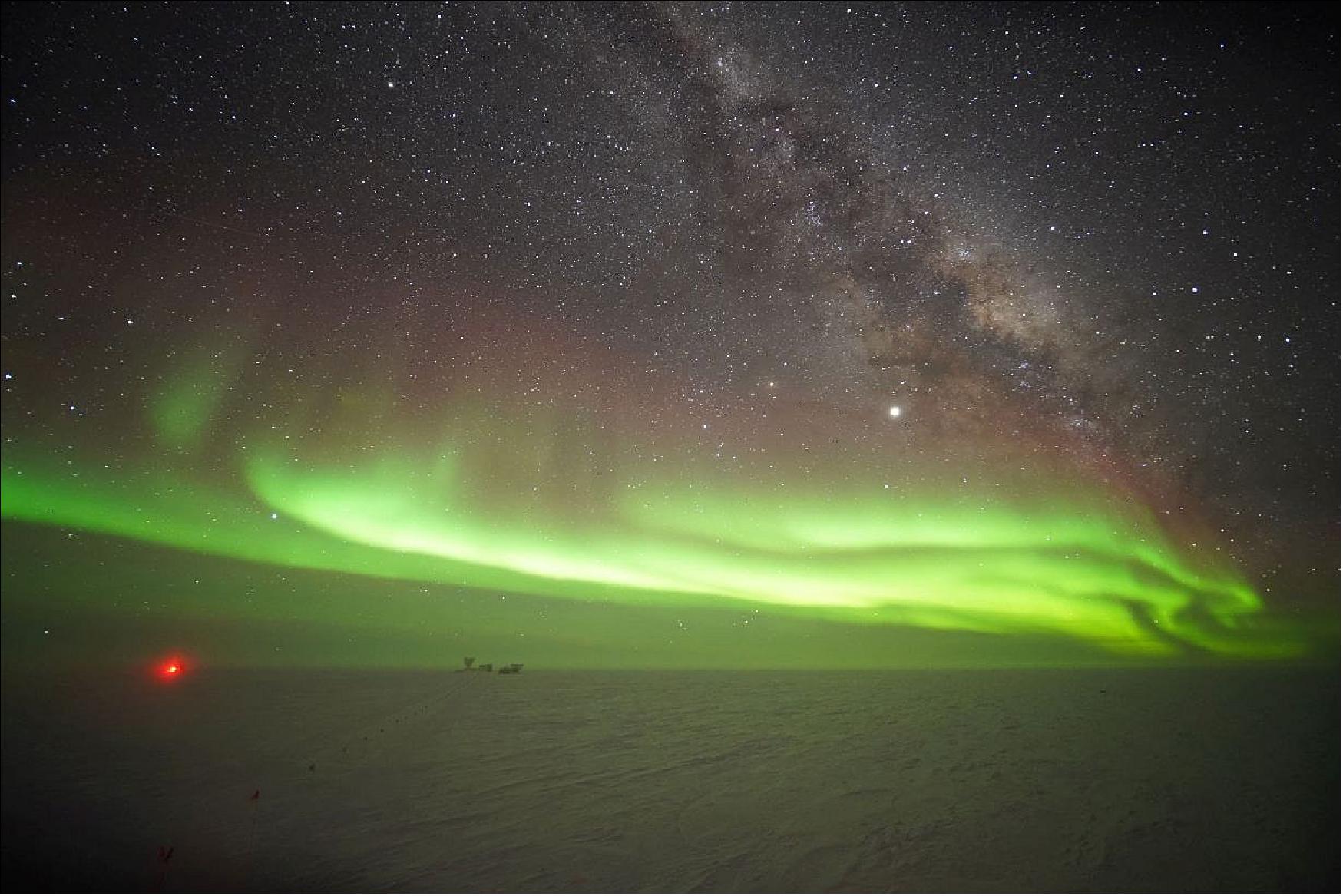
- IceCube serves to measure high-energy neutrinos in an ice volume of one cubic kilometer. As neutrinos proper do not emit any signals, the tracks of muons are measured precisely. Muons are elementary particles sometimes produced by the interaction of neutrinos with ice. Contrary to neutrinos, muons carry an electric charge. On their way through the ice, they produce a characteristic light cone, the so-called Cherenkov radiation. Highly sensitive detectors measure this blue radiation. Currently, 5160 detectors on86 cables are installed1500 to 2500 m deep in the ice.
- “Within the framework of the IceCube upgrade project, seven additional cable swill be installed deep in the ice in the middle of the existing lines. They are equipped with 700 upgraded detectors,” says Dr. Andreas Haungs, Head of the IceCube group of KIT. “The ice in and around the detector is highly transparent, which is ideal to study the properties of very quick, i.e. relativistic,particles.”

- The IceCube upgrade project in the amount of 37 million US dollars will be installed in the Antarctic summer 2022/23, partly financed by the USA with 23 million dollars from the “NSF Mid-scale Research Award”. The planned IceCube upgrade detector will consist of two different types of optical modules to test two technologies for the future tenfold enlargement of IceCube, IceCube-Gen2. One of the new optical sensors, the multi-Pixel Digital Optical Module (mDOM) was developed in Germany by groups at the universities of Erlangen-Nuremberg and Münster and by the German Electron Synchrotron DESY. DESY and KIT, as research centers of the Helmholtz Association, finance the construction of 430 mDOMs with a total of EUR 5.7 million. Compared to previous modules, mDOM has a much larger and segmented detection area, as a result of which a much higher sensitivity is reached.
- The Federal Ministry of Education and Research (BMBF) supports the collaboration of large-scale research institutes and universities in the IceCube project, an example being the development of optical and acoustic devices for the precise calibration of the detector, simulation and calibration methods, and the development of novel sensor concepts for IceCube-Gen2. “Together with measurements of other signals from the depth of the universe, such as cosmic rays, high-energy gamma quanta, or gravitation waves, the IceCube upgrade experiment will contribute decisively to solving the mysteries of physics of highest-energy processes in our universe,” expects Andreas Haungs.
• July 12, 2018: Observations made by researchers using a National Science Foundation (NSF) detector at the South Pole and verified by ground- and space-based telescopes have produced the first evidence of one source of high-energy cosmic neutrinos. These ghostly subatomic particles can travel unhindered for billions of light-years, journeying to Earth from some of the most extreme environments in the universe. 13)
- Data gathered by NSF's IceCube Neutrino Observatory at the foundation's Amundsen-Scott South Pole Station in Antarctica point to an answer to a more than century-old riddle about the origins of high-energy cosmic rays.
- That the detection was confirmed by other instruments, including an orbiting telescope operated by NASA, is a demonstration of the value of the emerging field of "multi-messenger astronomy," which describes the ability to marshal instruments globally to make and verify discoveries by combining data from messenger signals that reveal information about the universe.
- "The era of multi-messenger astrophysics is here," said NSF Director France Córdova. "Each messenger — from electromagnetic radiation, gravitational waves and now neutrinos — gives us a more complete understanding of the universe, and important new insights into the most powerful objects and events in the sky. Such breakthroughs are only possible through a long-term commitment to fundamental research and investment in superb research facilities."
- NSF's IceCube was built by NSF specifically to identify and track high-energy neutrinos. It sighted the first neutrinos from beyond our galaxy in 2013 and since has made numerous fundamental measurements in neutrino astronomy, which helps scientists make sense of matter in its most elementary forms.
- The NSF Office of Polar Programs, which manages the U.S. Antarctic Program (USAP), and the Physics Division in its Mathematical and Physical Sciences Directorate jointly oversee the operations of NSF's IceCube, the world's largest neutrino detector.
Mysterious Origins
- Since they were first detected in 1912, cosmic rays have posed an enduring mystery: What creates and propels them across vast distances before they rain down on Earth? Where do they come from?
- Cosmic rays are charged particles. This attribute makes tracing their paths back to their points of origin impossible, as the magnetic fields that fill space affect them, altering their trajectories. But the powerful, naturally occurring cosmic accelerators that produce cosmic rays also produce cosmic neutrinos. Neutrinos are uncharged particles, unaffected by even the most powerful magnetic fields. Because they rarely interact with matter and have almost no mass — hence their nickname "ghost particle" — neutrinos travel nearly undisturbed, giving scientists an almost direct pointer to their source.
- The group of international researchers that made this most recent discovery traced the path of a single neutrino detected by NSF's IceCube Sept. 22, 2017 to a previously known but little-studied blazar, the nucleus of a giant galaxy that fires off particles in massive jets of elementary particles, powered by a supermassive black hole at its core. Astronomers had designated this blazar as TXS 0506+056.
- The team published their results in two papers this week (July 13) in the journal Science.
- "The evidence for the observation of the first known source of high-energy neutrinos and cosmic rays is compelling," said Francis Halzen, a University of Wisconsin-Madison professor of physics and the lead scientist for the IceCube Neutrino Observatory.
- Equipped with a relatively new alert system — triggered when neutrinos of very high energies crash into an atomic nucleus in or near NSF's IceCube detector — the observatory sent coordinates to telescopes worldwide less than a minute after detection for follow-up observations.
- Two gamma-ray telescopes, NASA's orbiting Fermi Gamma-ray Space Telescope — which had already observed enhanced gamma-ray activity from the direction of the blazar during its regular scans of the entire sky every three hours — and the Major Atmospheric Gamma Imaging Cherenkov Telescopes (MAGIC) in the Canary Islands, looked in the direction provided by NSF's IceCube. They detected a flare of high-energy gamma rays associated with TXS 0506+056. The convergence of multi-messenger observations identified the blazar as the source.
High-Energy Particles
- Fermi was the first telescope to identify enhanced gamma-ray activity from TXS 0506+056 within 0.06 degrees of the IceCube neutrino direction. Over a decade of Fermi observations of this source, this was the strongest flare in gamma rays, the highest-energy photons. A later follow-up by MAGIC detected gamma rays of even higher energies.
- High-energy gamma rays can be produced either by accelerated electrons or protons. The observation of a neutrino, a hallmark of proton interactions, is the first definitive evidence of proton acceleration by black holes.
- "Now, we have identified at least one source of cosmic rays because it produces cosmic neutrinos," Halzen said. "Neutrinos are the decay products of pions. In order to produce them, you need a proton accelerator."
- The observations prove that TXS 056+056 is among the most luminous sources in the known universe and thus add support to a multi-messenger observation of a cosmic engine powerful enough to accelerate high-energy cosmic rays and produce the associated neutrinos. One of these neutrinos, out of many millions that sailed through Antarctica's ice, was captured by NSF's IceCube Sept. 22.
- Following the Sept. 22 detection, the IceCube team quickly scoured the detector's archival data -- NSF's IceCube is always on and looking in all directions, including through the Earth to the sky in the Northern Hemisphere -- and discovered a flare of neutrinos from December 2014, coincident with the same blazar, TXS 0506+056, which scientists have nicknamed "the Texas source."
- That independent observation greatly strengthens the initial detection of a single, high-energy neutrino and adds to a growing body of data that indicates that the blazar is the first known source of high-energy neutrinos and high-energy cosmic rays.
Neutrino Detection Methods
- The crystal-clear ice beneath the South Pole provides the medium that allows NSF's IceCube to document the interaction of neutrinos with terrestrial matter. Collisions between high-energy neutrinos and atomic nuclei are very rare but produce an unmistakable signature — a characteristic cone of blue light that is mapped through the detector's grid of 5,000 photomultiplier tubes.
- When a neutrino slams into the nucleus of an atom, it creates one or more secondary charged particles, which, in turn, create the blue light. Because the charged particle and light it creates stay essentially true to the neutrino's direction, it gives scientists a path to follow back to a source.
- NSF's IceCube observatory is operated by an international collaboration that includes more than 300 scientists from 49 different institutions in 12 countries. The observatory is part of the Wisconsin IceCube Particle Astrophysics Center, based at the University of Wisconsin. The center brings together scientific, engineering, computing and educational resources around the theme of particle astrophysics.
- The NSF-managed USAP built and maintains the IceCube observatory in one of the world's harshest environments. The need to ship all of the components to build the detector in the holds of military cargo aircraft, as well as the development of hot-water drilling techniques required to install instruments into the ice sheet, make NSF's IceCube, which became operational in 2010, the culmination of a uniquely challenging scientific and logistical endeavor.
- NSF provided approximately $242 million of the total cost of building IceCube, while other partners provided an additional $37 million. NSF also provides $7 million annually to operate and maintain the facility.
- About 20 observatories on Earth and in space have participated in this discovery. The observations across the electromagnetic spectrum, listed alphabetically by project for the given wavelength, include: gamma-rays by the space missions AGILE, INTEGRAL, and Fermi and ground-based telescopes HAWC in Mexico, H.E.S.S. in Namibia, MAGIC in Spain, and VERITAS in the U.S.; X-rays, optical, and radio radiation by space missions MAXI, NuSTAR, and Swift and ground-based observatories ASAS-SN in Chile and the U.S., GTC in Spain, Kanata in Japan, Kapteyn in Spain and the U.S, Kiso in Japan, Liverpool in Spain, OVRO in the U.S., SALT in South Africa, Subaru in Japan, and VLA in the U.S; and neutrinos by ANTARES in France. These observatories are run by international teams with a total of over a thousand scientists supported by funding agencies in countries around the world. Several follow-up observations are detailed in a few other papers that are also released today.
References
1) ”IceCube Overview,” UW (University of Wisconsin-Madison), URL: https://icecube.wisc.edu
/about-us/overview/
2) ”Meet the Collaboration,” UW, URL: https://icecube.wisc.edu/collaboration/meet-the-collaboration/
3) ”IceCube detection of a high-energy particle proves 60-year-old theory,” UW, 10 March 2021, URL: https://icecube.wisc.edu/news/press-releases/2021/
03/icecube-detection-of-a-high-energy-particle-proves-60-year-old-theory/
4) The IceCube Collaboration, ”Detection of a particle shower at the Glashow resonance with IceCube,” Nature, Published: 10 March 2021,https://doi.org/10.1038/s41586-021-03256-1
5) Madeleine O'Keefe, ”New IceCube analysis sets upper limits on time-dependent neutrino sources,” UW, 3 December 2020, URL: https://icecube.wisc.edu/news/research/2020/12/
new-icecube-analysis-sets-upper-limits-on-time-dependent-neutrino-sources/
6) IceCube Collaboration, R. Abbasi, M. Ackermann, J. Adams, J. A. Aguilar, ... and Z. Zhang. ”A search for time-dependent astrophysical neutrino emission with IceCube data from 2012 to 2017,” High Energy Astrophysical Phenomena (astro-ph.HE), Published: December 2020, https://arxiv.org/abs/2012.01079
7) Madeleine O'Keefe, ”Can a high-energy neutrino detector see low-energy neutrinos?,” UW-Madison news, 12 November 2020, URL: https://icecube.wisc.edu/news/research
/2020/11/can-high-energy-neutrino-detector-see-low-energy-neutrinos/
8) Madeleine O'Keefe, ”IceCube-Gen2 will open a new window on the universe,” UW news, 18 August 2020, URL: https://icecube.wisc.edu/news/research/
2020/08/icecube-gen2-will-open-new-window-on-universe/
9) The IceCube -Gen2 Collaboration, M. G. Aartsen, R. Abbasi, M. Ackermann, .... M. Zöcklein, ”IceCube-Gen2: The Window to the Extreme Universe,” Journal of Physics, August 2020, URL: https://arxiv.org/pdf/2008.04323.pdf
10) Madeleine O'Keefe, ”Searching for neutrino emission from 11 LIGO-Virgo gravitational wave sources,” UW-Madison news, 17 July 2020, URL: https://icecube.wisc.edu/news/research/2020
/07/searching-for-neutrino-emission-from-11-ligo-virgo-gravitational-wave-sources/
11) M. G. Aartsen, M. Ackermann, J. Adams, J. A. Aguilar, ....and M. Zöcklein, ”IceCube Search for Neutrinos Coincident with Compact Binary Mergers from LIGO-Virgo's First Gravitational-wave Transient Catalog,” The Astrophysical Journal Letters, Volume 898, Number 1, Published: 17 July 2020, https://doi.org/10.3847/2041-8213/ab9d24
12) Monika Landgraf, ”Antarctic: The IceCube Neutrino Experiment Is Growing,” KIT Press Release, 16 July 2019, URL: https://www.kit.edu/downloads/pi/
PI_2019_096_Antarctic%20-%20The%20IceCube%20Neutrino%20Experiment%20Is%20Growing.pdf
13) ”Neutrino observation points to one source of high-energy cosmic rays,” NSF News Release 18-050, 12 July 2018, URL: https://www.nsf.gov/news/news_summ.jsp?cntn_id=295955
The information compiled and edited in this article was provided by Herbert J. Kramer from his documentation of: ”Observation of the Earth and Its Environment: Survey of Missions and Sensors” (Springer Verlag) as well as many other sources after the publication of the 4th edition in 2002. - Comments and corrections to this article are always welcome for further updates (eoportal@symbios.space).